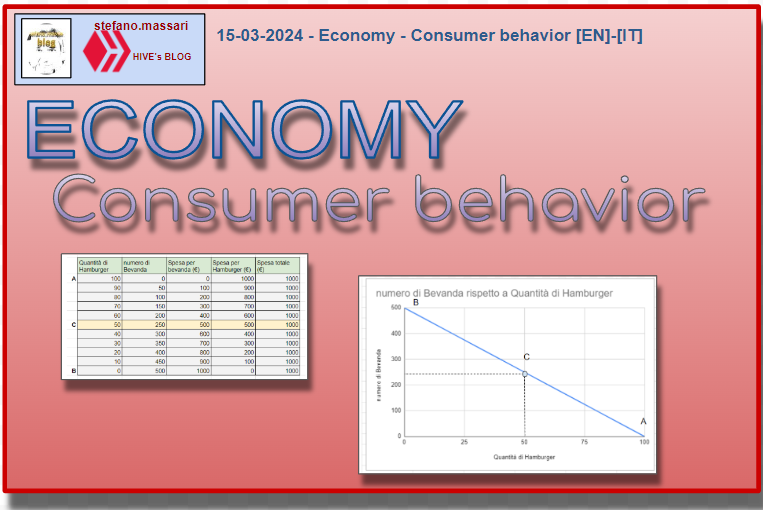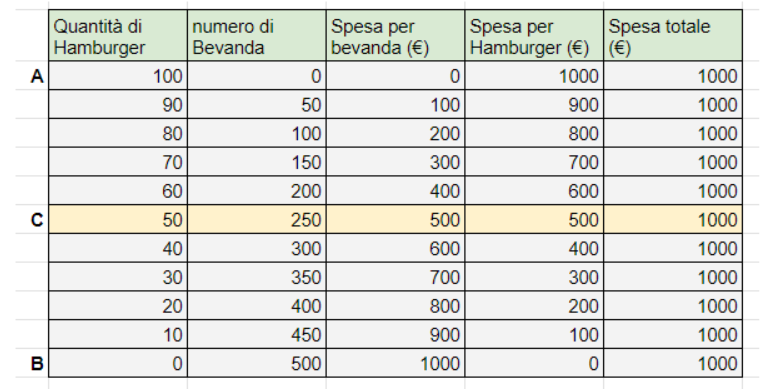
~~~ La versione in italiano inizia subito dopo la versione in inglese ~~~
ENGLISH
15-03-2024 - Economy - Consumer behavior [EN]-[IT]
Consumer behavior
Brief notes
Consumer behavior is one of those things that a business absolutely must take into account.
Therefore for a business activity it is necessary to know the consumer's decision-making behaviour, how the consumer decides to purchase, what leads a consumer to repeatedly prefer a certain product, how his purchasing choices are influenced by advertising and what is the real influence of brands on consumer behavior.
It must be taken into account that buyers are rational, that each of them aims to maximize their own utility and each buyer pursues their own personal interest.
There are then a series of consumer characteristics that need to be evaluated. I list these features below:
Constraint, income, value, opportunity cost, utility, total utility, increasing total utility, marginal utility and decreasing marginal utility, preferences, indifference curves and finally Marginal Rate of Substitution (SMS)
Consumer equilibrium
What is the consumer's equilibrium?
The consumer's equilibrium is given by the quantity of goods that he wants to purchase of two different goods and the relative prices.
In the study of consumer equilibrium we must insert a new term, the trade-off. This is a situation involving a choice between two possibilities, in which a decrease in one quantity constitutes an increase in another quantity.
Below is an example with a graph to better understand the concept of trade-off
Let's imagine that the consumer has to buy drinks and hamburgers with a cost of €1000
Let's consider the consumer's trade-off aimed at reducing the quantity of the hamburger good compared to the drink good.
The slope of the budget constraint curve is the difference between relative prices.
In this case, how many drinks or burgers would I have to give up to get an extra amount of
drinks or burgers.
Below is an example with data table and graph


Consumer preferences
Preferences allow the consumer to choose between different combinations. In the case seen before, you can choose between different quantity combinations of drinks and hamburgers.
However, it may happen that not just one combination is preferred by the consumer. In some cases the consumer could be indifferent when faced with different choices, that is, he could like not only one solution, but also others.
This condition gives rise to the principle of indifference curves.
The optimal point between indifference curves
When there are several indifference curves, the consumer will have to decide which one is right for him and to make this choice he will take into account the budget constraint.
Usually the consumer tends to always choose the indifference curve furthest from the origin and which is tangent to the budget constraint. This point is defined as the optimal point.
We remember that the slope of the curve is given by the Marginal Rate of Substitution (SMS), while the slope of the budget constraint line is given by the ratio between prices and therefore we will have that:

Change in income
The change in income causes changes to the graphs.
Example:
-As income increases, the budget constraint shifts to the right and if we consider the graph shown previously, the consumption of beer will increase, also causing the consumption of pizza.
Price change
What can cause a price change?
The constraint rotates outward as the constraint is the price ratio. By changing the price of the drink (it goes from 2 to 1), the ratio between the price of the drink and the hamburger consequently changes (it goes from 5 to 10). As a result, the slope of the budget constraint will change.
Income and replacement
What is the effect that income produces?
The income effect is given by the transition from a lower indifference curve to a higher one precisely due to the fact that income has increased. It is also necessary to consider as an increase in income a possible decrease in an asset which allows the income to have a greater impact on purchases.
What is the substitution effect?
The substitution effect is given by the transition from a combination of two goods on the same indifference curve.
Behavioral Economics
In behavioral economics, human beings are not considered rational, but with limited rationality. Furthermore, it has been studied that individuals often place excessive confidence in themselves and sometimes give excessive weight to a few observations that are stronger than others.
Behavioral economics also suggests that humans are unwilling to change their minds and tend to construct examples to reinforce their preconceived opinions.
Advertising
Advertising is used in imperfectly competitive markets where the products for sale are differentiated and higher prices are charged at marginal cost.
We don't see much advertising on homogeneous products, such as flour for example.
Advertising can be provided with a precise information message or with an unconscious or subliminal message.
Asymmetric information
Asymmetric information is a hidden action.
To reduce cases of asymmetric information, screening can be done to detect information in a more detailed manner.
Conclusions
In behavioral economics, humans are considered to have limited rationality.
Request
Sometimes economic markets seem irrational to me.
Given the conclusions, i.e. that in economics the human being is considered as not very rational, has it occurred to you too that the same thing applies to the investor?

ITALIAN
15-03-2024 - Economia - Il comportamento del consumatore [EN]-[IT]
Il comportamento del consumatore
Brevi cenni
Il comportamento del consumatore è una di quelle cose che un'impresa deve assolutamente tenere conto.
Quindi per un'attività d’impresa è necessario conoscere il comportamento decisionale del consumatore, come il consumatore decide di acquistare, cosa induce un consumatore a preferire ripetutamente un certo prodotto, come vengono condizionate le sue scelte d’acquisto rispetto alla pubblicità e qual è la reale influenza dei marchi su comportamento dei consumatori.
Bisogna tenere conto che i compratori sono razionali, che ognuno di loro mira a massimizzare la propria utilità ed ogni compratore persegue il proprio interesse personale.
Ci sono poi una serie di caratteristiche del consumatore che sono da valutare. Queste caratteristiche le elenco qui sotto:
Vincolo, reddito, valore, costo-opportunità, utilità, utilità totale, utilità totale crescente, utilità marginale ed utilità marginale, decrescente, preferenze, curve di indifferenza ed infine Saggio Marginale di Sostituzione (SMS)
Equilibrio del consumatore
Da cosa è dato l’equilibrio del consumatore?
L’equilibrio del consumatore è dato dalla quantità di beni che lo stesso vuole acquistare di due beni diversi ed i prezzi relativi.
Nello studio dell’equilibrio del consumatore dobbiamo inserire un nuovo termine, il trade-off. Questo è una situazione che implica una scelta tra due possibilità, in cui la diminuzione di una quantità costituisce un aumento in un'altra quantità.
Qui di seguito un esempio con grafico per capire meglio il concetto di trade-off
Immaginiamo che il consumatore debba acquistare bevande e hamburger con una spesa di 1000 €
Consideriamo il trade-off del consumatore rivolto al fatto di ridurre la quantità del bene hamburger nei confronti del bene bevanda.
La pendenza della curva del vincolo di bilancio è la differenza tra i prezzi relativi.
In questo caso, a quante bevande o hamburger dovrei rinunciare per ottenere una quantità in più di
bevande o hamburger.
Qui di seguito un esempio con tabella dati e grafico


Le preferenze del consumatore
Le preferenze permettono al consumatore di scegliere tra diverse combinazioni. Nel caso visto prima può scegliere tra diverse combinazioni di quantità tra bevande e hamburger.
Può capitare però che non sia solo una la combinazione preferita dal consumatore. In alcuni casi il consumatore potrebbe essere indifferente davanti a diverse scelte, cioè potrebbe gradire non solo una soluzione, ma anche altre.
Questa condizione dà vita al principio delle curve di indifferenza.
Il punto ottimo tra curve di indifferenza
Quando saranno presenti diverse curve di indifferenza, il consumatore dovrà decidere quale fa al caso proprio e per fare questa scelta terrà conto del vincolo di bilancio.
Solitamente il consumatore tende a scegliere sempre la curva di indifferenza più lontana dall’origine e che sia tangente al vincolo di bilancio. Questo punto viene definito come punto di ottimo.
Ricordiamo che la pendenza della curva è data dal Saggio Marginale di Sostituzione (SMS), mentre la pendenza della retta del vincolo di bilancio è data dal rapporto tra i prezzi e quindi avremo che:

Variazione del reddito
La variazione del reddito provoca dei cambiamenti ai grafici.
Esempio:
-All’aumentare del reddito il vincolo di bilancio si sposta verso destra e se consideriamo il grafico mostrato in precedenza aumenterà il consumo di birra provocando anche un consumo di pizza.
Variazione di prezzo
Cosa può provocare una variazione di prezzo?
Il vincolo ruota verso l’esterno in quanto il vincolo è il rapporto tra i prezzi. Cambiando il prezzo della bevanda (passa da 2 a 1), di conseguenza cambia il rapporto tra il prezzo della bevanda e dell’ hamburger (passa da 5 a 10). Di conseguenza la pendenza del vincolo di bilancio cambierà.
Reddito e sostituzione
Quel è l’effetto che produce il reddito?
L’effetto reddito è dato dal passaggio da una curva di indifferenza più bassa di una più alta proprio a causa del fatto che il reddito è aumentato. Bisogna considerare anche come aumento del reddito un'eventuale diminuzione di un bene che mette in condizione il reddito di incidere di più negli acquisti.
Cosa è l’effetto sostituzione?
L’effetto sostituzione è dato dal passaggio dal passaggio da una combinazione di due beni sulla stessa curva di indifferenza.
Economia comportamentale
In economia comportamentale gli esseri umani non vengono considerati come razionali, ma con razionalità limitata. Inoltre si è studiato che gli individui spesso ripongono eccessiva fiducia in sé stessi e a volte attribuiscono un peso eccessivo a poche osservazioni più forti di altre.
L’economia comportamentale inoltre suggerisce che gli esseri umani sono poco disposti a cambiare idea e tendono a costruire esempi per rafforzare le proprie opinioni precostituite.
La pubblicità
La pubblicità viene utilizzata nei mercati a concorrenza imperfetta dove i prodotti in vendita sono differenziati e vengono applicati prezzi più alti al costo marginale.
Sui prodotti omogenei, come ad esempio può essere la farina, non vediamo molta pubblicità.
La pubblicità può essere fornita con un preciso messaggio di informazione o con un messaggio inconscio o subliminale.
Informazione asimmetrica
L'informazione asimmetrica è un'azione nascosta.
Per ridurre i casi di informazione asimmetrica si può fare uno screening per rilevare le informazioni in maniera più capillare.
Conclusioni
In economia comportamentale gli esseri umani vengono considerati come se avessero una razionalità limitata.
Domanda
A volte i mercati economici a me sembrano irrazionali.
Viste le conclusioni, cioè che in economia l'essere umano viene considerato come poco razionale, anche a voi è venuto in mente che vale la stessa cosa per l'investitore?
THE END